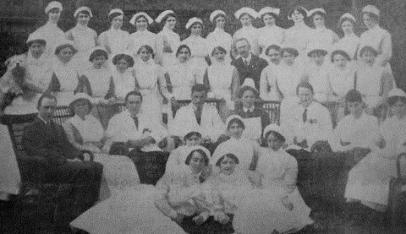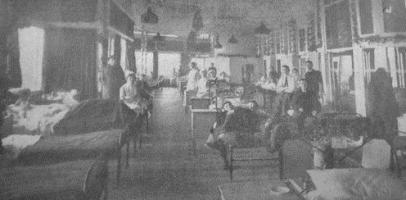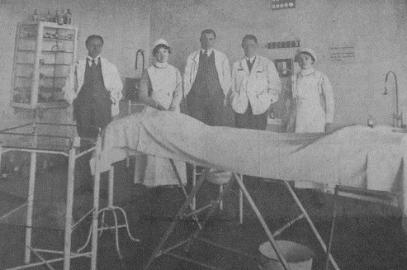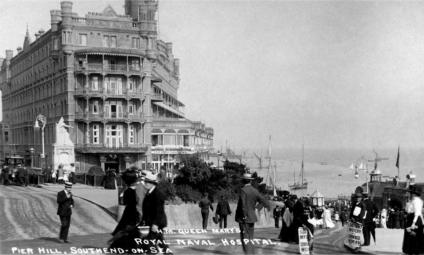Queen Mary’s Naval Hospital

Southend Timeline Southend-on-Sea © 2009 - 2024. All Rights Reserved
Palace Hotel

On
the
outbreak
of
War
in
August
1914,
when
the
thoughts
of
all
civilians
were
turned
to
making
adequate
preparations
for
the
treatment
of
sick
and
wounded
sailors
and
soldiers,
it
was
at
once
seen
how
admirably
the
Palace
Hotel
in
Southend,
with
its
splendid
position
overlooking
the
Thames
Estuary,
could
be
adapted
for
the
purpose
of
a
Hospital.
The
owners,
Messrs.
Tolhurst,
were
approached
on
the
subject
and
they
immediately
offered,
in
the
most
generous
manner,
to
grant
the
use
of
entire
building
free
of
rent
for
the
duration
of
the
War.
An
influential
committee
was
formed
under
the
presidency
of
Her
Majesty
the
Queen,
and
sufficient
funds
were
subscribed
to
thoroughly
equip
and
furnish
the
Hospital
in
compliance
with
modern
standards
of
the
day.
It
was
foreseen
that
the
logistics
of
transporting
patients
from
the
ambulance
trains
to
the
Hospital
needed
addressing.
Two
detachments
of
the
St.
John’s
Ambulance
Men’s
V.A.D’s,
(Voluntary
Aid
Detachments),
were
formed
and
specially
trained
for
the
work
under
the
control
of
Superintendent
H.
Langley
Jones,
who
had
done
such
yeoman
service
in
the
cause
of
ambulance
work
in
the
Borough.
On
October
5th
1914
urgent
instructions
were
sent
to
the
Hospital
to
prepare
to
receive,
on
the
following
day,
168
wounded
Belgians
from
the
fighting
around
Liege,
Namur
and
Antwerp.
It
was
short
notice
but,
most
efficiently
aided
by
the
Church
Lad’s
Brigade,
under
Major
F.
C.
Smith,
who
worked
throughout
the
night
fitting
beds,
and
the
Borough
of
Southend
and
other
Needlework
Guilds,
who generously furnished large supplies of sheets pillows and other necessary linen.
Few
who
were
in
the
Borough
in
those
opening
days
of
the
War
will
forget
the
excitement
caused
by
the
arrival
of
the
first
wounded.
Hour
after
hour
the
ambulance
train
was
expected,
but
it
was
not
until
two
in
the
morning
that
those
whose
duty
took
them
to
the
Great
Eastern
Station
saw
lights
of
the
train
coming
slowly
through
the
morning
mist
and
draw
up
at
the
platform.
The
Southend
and
District
Automobile
Club,
under
the
charge
of
Mr
William
C.
Mellor,
had
provided
an
ample
number
of
motor
cars,
and
the
newly trained ambulance men commenced their work of transferring the wounded to the Hospital.
Thousands
of
residents
in
the
Borough
had
waited
up
to
greet,
with
resounding
cheers,
the
men
who
had
so
bravely
held
the
Germans
at
bay,
causing
the
transit
to
the
Hospital
to
resemble
a
triumphal
procession,
and
it
was
not
until
four
in
the
morning
that
the
tired
ambulance
men
were
able
to
rest
from
their
labours.
For
the
next
few
days
the
Hospital
was
the
centre
of
attraction,
crowds
gathered
round
to
shower
gifts
of
cigarettes,
tobacco
and
comforts
of
all
kinds
on
the
wounded
Belgians
who had gathered on the balconies.
Heroes of Mons
A
few
weeks
later
a
further
demonstration
was
caused
by
the
arrival
of
the
first
wounded
men
of
the
British
Expeditionary
Force,
the
heroes
of
Mons
Le
Cateau
and
other
battlefields
of
the
historic
retreat.
They
had
much
to
tell
of
their
hardships
endured
during
the
anxious
time
before
the
great
battle
of
the
Marne
had
stemmed
the
tide
of
the
German
invasion of France.
From
that
time
onward
ambulance
trains
arrived
at
intervals
of
two
and
three
weeks,
bringing
men
from
Ypres,
Neuve
Chappel,
Festubert
and
many
other
hard
fought
fields
of
battle,
as
well
as
those
who,
through
the
bitter
cold
of
the
winter,
had
held
the
sodden
trenches
on
the
British
front.
As
quickly
as
the
fostering
care
of
the
doctors
and
nurses
had
restored
the
men
to
health,
their
places
were
taken
by
fresh
casualties
straight
from
the
front.
The
greatest
interest
was
taken
in
the
welfare
of
the
men
by
the
inhabitants
of
the
Borough
who,
with
the
greatest
generosity,
brought
to
the
Hospital
gifts
of
money
and
kind,
as
well
as
arriving
in
numbers,
on
visiting days, to sympathise with the patients and hear first-hand of their adventures in the fighting line.
On
March
28th
1915
the
first
“Gift
Day”
in
aid
of
the
Hospital
was
held.
Her
Grace
The
Duchess
of
Portland
attended
to
personally
receive
gifts
from
friends
of
the
Hospital,
who
came
in
such
numbers
that
it
was
necessary
to
form
a
queue
four
people
deep,
extending from the Hospital door well past the building and St John’s Church into the next street.
Some
10,000
eggs,
jam
by
the
cwt.,
tea,
coffee
and
provisions
of
all
kinds
were
brought
to
the
Hospital,
in
addition
to
generous
contributions
of
money
from
all
classes
of
the
community;
one
small
boy
presented
his
pet
rabbit
which
was
sold
for
the
good
of
the
fund.
In
June
1915
the
Hospital
was
honoured
by
a
visit
from
Her
Majesty
the
Queen.
She
was
received
by
the
Mayor
as
the
representative
of
the
Borough,
and
the
Committee
and
resident
staff
of
the
Hospital.
Her
Majesty
visited
every
ward,
graciously
conversing
with
each
patient
and
making
sympathetic
enquiries
as
to
the
nature,
and
circumstances,
of
his
injury.
Her
Majesty
was
greatly
pleased
with
the
beautiful
situation
and
cheerful
surroundings
of
the
wards,
and
expressed
her
gracious
approval
of
the
administration
of
the
Hospital
so
intimately
associated
with
her
name.
Members
of
staff
were
then
presented
to
the
Queen,
after
which
Her
Majesty
took
tea with the Matron before entering her car and making a short tour of the Borough prior to motoring back to town.
The Fighting at Gallipoli
All
through
the
spring
and
summer
sick
wounded
men
continued
to
flow
in,
from
the
battlefield
at
the
front,
suffering
from
every
kind
of
wound
–
from
shell-shock,
trench
foot,
the
effects
of
gas,
and
various
other
ailments
incidental
to
the
campaign.
Towards
the
end
of
September
men
of
the
Royal
Naval
Division,
from
the
fighting
at
Gallipoli,
began
to
be
received
in
increasing
numbers
at
the
Hospital;
the
average
number
of
beds occupied varied from 200 to 250.
In
the
beginning
of
1916
the
demand
for
beds
became
still
more
urgent
and
the
number
was
increased
to
300.
The
wounded
from
the
first
great
push
on
the
Somme
caused
them
to
be
constantly
full.
The
large
increase
in
the
personnel
of
the
Navy,
and
the
number
of
the
wounded
from
the
battle
of
Jutland,
caused
a
demand
for
more
Naval
beds.
Further
wards
were
opened
and
accommodation
provided
for
350
beds
divided
between
the Army and the Navy.
In
the
March
the
Admiralty
notified
the
Hospital
authorities
that,
in
consequence
of
the
pressure
at
the
Naval
Base
Hospitals,
they
desired
the
use
of
the
entire
350
beds,
Queen
Mary’s
having
been
originally
founded
for
the
purpose
of
an
auxiliary
Naval
Hospital
(it
being
the
only
institution
of
its
kind
in
the
south
of
England).
The
Committee
approached
the
Military
authorities
who
consented,
in
the
circumstances,
to
transfer
all
Military
cases
to
other
Hospitals.
On
March
22nd
most
of
the
Military
patients
were
transferred
to
the
Glen,
Overcliff
and
Victoria
Hospitals
in
the
Borough,
and
the
remaining
cases
to
Chatham.
It
was
quite
an
affecting
scene
when
the
soldiers
left.
They
gave
cheers
for
the
matron,
doctors,
nurses
and
staff,
and
expressed
their
deep
regret
at
the
termination
of
the
happy time that, notwithstanding their injuries, they had spent at Queen Mary’s.
Since
the
opening
of
the
Hospital,
169
Belgian
soldiers,
3,475
British
soldiers
and
1,025
British
sailors,
totalling
4,669
men
had
received
treatment.
This
entailed
the
services
of
two
resident
and
eight
visiting
local
medical
men,
the
matron
and
staff
of
fully
qualified
sisters,
nurses,
a
radiographer,
and
domestic
staff,
and
six
London
specialists
visiting
the
Hospital
as
their
services
were
required.
In
addition
to
dental
and
minor
operations
2,000
x-rays
had
taken
place,
and
over
1,200
operations had been carried out in the theatre.
Of
the
4,669
patients
only
37
died,
giving
a
percentage
of
well
below
1,
notwithstanding
that
every
type
of
case
had
been
taken,
frequently,
direct from the firing line.
The
matron,
resident
doctors,
and
great
majority
of
the
sisters,
received
their
early
training
at
Guy’s
Hospital,
of
which
Dr.
W.
Hale
White,
chairman
of
the
Committee,
is
one
of
the
consulting
physicians.
The
extraordinary
and
continued
kindness
shown
to
the
patients,
by
the
Borough, was most deeply and gratefully appreciated by the men.
Entertaining the Wounded
All
through
the
fine
weather
the
members
of
the
Southend
and
District
Automobile
Club,
and
the
National
Motor
Volunteers,
took
the
men
for
motor
rides,
generally
to
entertainments
provided
for
them
by
ladies
and
gentlemen
with
beautiful
country
houses
and
grounds
in
the
surrounding
districts.
They
also
conveyed
the
more
severe
cases
to
concerts,
teas
and
other
entertainments
so
lavishly
provided
by
clubs,
associations
and
congregations
of
every
kind,
in
various
halls,
theatres
or
schoolrooms
in
the
Borough.
Week
after
week
the
artistes,
performing
at
the
Hippodrome,
devoted
Friday
afternoons
to
visiting
the
Hospital
to
give
the
best
of
their
repertoire
to
the
wounded
men
in
the
bijoux
theatre
created
in
the
dining
hall.
Many
of
the
men
who
were
unable
to
leave
their
beds
were
carried
to
the
dining
hall
so
that
they
too
could
enjoy
the
efforts
of
the
talented
companies
always
provided
by
Mr
Thompson
the manager. The total number of entertainments given amounted to 110.
Every
provision
was
made
for
the
amusement
of
the
men
in
the
Hospital.
Four
billiard
tables
were
at
their
disposal
for
practise,
and
for
competitions
between
wards
or
individual
players.
Gentlemen
of
the
neighbourhood,
who
were
experts
at
the
game,
were
frequently
good
enough
to
give
exhibition
matches
to
encourage
the
weaker
players.
Whist
drives
were
organised
among
the
men
from
time
to
time,
and
prizes
were
provided
by
various
friends
of
the
Hospital.
A
sing-song
was
arranged
each
week,
plenty
of
talent
usually
being
available
among
the
patients,
occasionally
assisted
by
members
of
the
staff.
Seldom
a
week
went
by
without
a
concert
being
given
by
one
or
another
of
the
talented
concert
parties,
pierrot
troupes,
glee
singers,
and
other
musical
friends
with
whom
the
Borough
was
so
richly
endowed.
To
hear
the
lusty
manner
in
which
the
men
joined
in
the
choruses
was
sufficient
evidence
of
how
much
they
enjoyed,
and
appreciated,
the
kindness
of
their
entertainers.
Daily Routine
After
an
early
breakfast
the
ordinary
routine
of
the
wards
commenced.
Beds
had
to
be
made,
wards
cleaned
and
tidied,
and
everything
made
fresh
and
clean
for
the
day.
This
work
was
largely
carried
out
by
the
voluntary
lady
orderlies
of
the
Essex
V.A.D.,
who
nobly
came
forward
to
supplement
the
regular
male
orderly
staff
whose
ranks
had
been
greatly
depleted
in
consequence
of
so
many
having
joined
His
Majesty’s
Forces.
These
ladies
provided
a
most
excellent
service,
helping
with
the
meals,
dressings,
domestic
work, and the hundred and one other small details of the efficient carrying out of duties on which so much depended.
Dinner
was
at
twelve
o’clock.
Feeding
350
men
in
various
stages
of
ill-health,
and
convalescence,
involved
a
tremendous
amount
of
organisation
to
ensure
that
every
man
got
his
meal
hot
and
well
served.
At
1.30pm
the
patients
who
were
well
enough
were
allowed
out
to
visit
their
friends,
or
to
take
advantage
of
the
kind
offer
of
the
cinema
theatres,
Kursaal,
and
other
places
of
entertainment,
to
admit them free of all charge.
Tea
was
served
at
4.30pm
to
those
in
the
Hospital,
but
the
men
who
were
out
largely
availed
themselves
of
the
many
kind
invitations
to take tea with friends in the town. Supper was at 8pm, and at 9 o’clock it was “lights out”.
The Work of the V.A.D’s
The
duty
of
supplementing
the
night
orderly
staff
was
undertaken
by
the
members
of
the
43rd
and
35th
V.A.D’s,
who
voluntarily
gave
hundreds
of
hours
to
this
wearisome
duty,
remaining
at
their
post
from
7pm
to
7am
the
next
morning.
In
addition
to
that,
on
hearing
any
alarm
of
approaching
aircraft
danger,
a
number
of
members
of
the
Detachment
immediately
attended
at
the
Hospital
and remained until all threat of danger had passed, often not until the early hours of the morning.
It
was
impossible
to
indicate
even
a
tithe
of
the
many
acts
of
kindness,
generosity,
and
willing
service
rendered
by
the
inhabitants
of
Southend,
and
the
surrounding
districts,
to
the
inmates
of
Queen
Mary’s
Hospital,
but
the
widespread
interest
displayed
in
our
soldiers
who
came
to
that
haven
suffering
from
sickness,
and
wounds
received
at
the
Front,
undoubtedly
continued
to
be
extended
to
the sailors who continued to fill the wards.
Although,
perhaps
not
appealing
as
much
to
the
imagination
as
duty
in
the
trenches,
the
wounds,
sickness
and
strain
caused
by
the
long
vigil
of
our
sailors,
by
day
and
night,
in
the
North
Sea
entitled
them
to
every
bit
as
much
sympathetic
help
and
consideration
as
had
been
so
lavishly
extended
to
the
land
forces.
The
fact
that
Queen
Mary’s
Hospital
had
been
reverted
to
the
purpose
for
which
it
was
founded
made
no
difference
whatsoever
in
the
direction,
administration,
nor
in
the
nursing
staff.
Everything
remained
the
same
with
the
exception
that
every
bed
would,
in
future,
be
reserved
for
the
men
of
that
splendid
Fleet
on
which
the
entire
defence
of
the
Empire was based.







Southend-on-Sea’s No 1 History Website! Documenting The Town & The Townspeople

Now Incorporating The Sea Of Change Website
Website Info:


Chalkwell ▪ Eastwood ▪ Leigh-on-Sea ▪ Prittlewell ▪ Shoeburyness ▪ Southchurch ▪ Thorpe Bay ▪ Westcliff-on-Sea
SOUTHEND CITY
































































